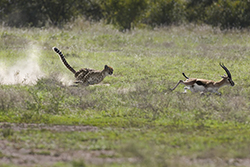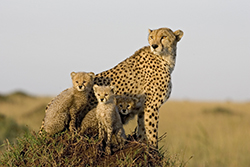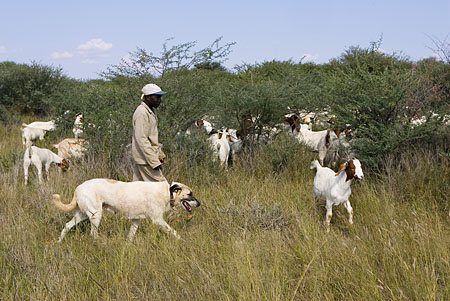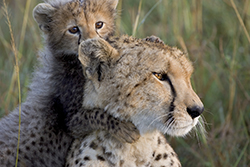
|
|
 |
||||||||||||||||||||
|
|
|||||||||||||||||||||
|
CHEETAH CONSERVATION FUND Celebrating 20 Years of Helping the Endangered African Cheetah By Jon Deinzer Photos courtesy of Suzi Eszterhas  Most of us are aware of the speed and beauty of the cheetah - the world’s fastest land mammal - but one of the things you might not be aware of is that approximately 90% of all young cheetahs born in the wild will die during their first year of life. Falling victim to other cats such as lions and leopards, they’re also especially susceptible to diseases. Most of us are aware of the speed and beauty of the cheetah - the world’s fastest land mammal - but one of the things you might not be aware of is that approximately 90% of all young cheetahs born in the wild will die during their first year of life. Falling victim to other cats such as lions and leopards, they’re also especially susceptible to diseases.The cheetah, which now gets to claim membership in the “extremely-endangered species” club, originally roamed vast grassland ranges from southeastern Europe, across the Middle East as far as India, and down into Africa. In 1900, their population was estimated to be more than 100,000 in Africa and Asia, yet over the years we have reduced their range of wild habitat to only select areas of eastern and southeastern Africa. Another factor in their decline in numbers can be attributed to  their superior hunting ability, as they were trained by early pre-Christian tribes as hunting companions. But the recent and sharpest reduction in wild cheetahs comes from genetic inbreeding (cheetahs are the sole member of their genus), a human desire for their skins, and the relentless destruction of their habitats and the food stock that lives there. their superior hunting ability, as they were trained by early pre-Christian tribes as hunting companions. But the recent and sharpest reduction in wild cheetahs comes from genetic inbreeding (cheetahs are the sole member of their genus), a human desire for their skins, and the relentless destruction of their habitats and the food stock that lives there.All is not lost for these speedsters however, because as most of us sit on our couches watching the latest installment of “vampire-meets-The-Big-Easy,” there are others out there who are getting up out of their comfortable lives and actually doing something about the cheetah’s plight. Dr. Laurie Marker is just such a person. Twenty years ago, Dr. Marker founded the Cheetah Conservation Fund (CCF), a place where injured or orphaned cheetahs can roam freely along the thorn bush savannas. Dr. Marker, a wildlife conservationist, opened the center in 1990 after spending 16 years studying these great cats in a wildlife  park in Oregon where she ran a veterinary clinic. park in Oregon where she ran a veterinary clinic. Although the CCF is located on a vast patch of land in Namibia (where the single, largest population of cheetahs exist), their influence is worldwide. CCF is providing training and developing programs with other countries where the cheetahs live; as a result, South Africa, Zimbabwe, Botswana and Algeria have all joined the fight to save the cheetah, and countries that have existing programs like Kenya, South Africa and Iran have also joined forces with the CCF to incorporate the latest facts and findings into their existing programs. At the main facility in Namibia, where the current cheetah population is approximately 3,000, education and implementation are the name of the game. CCF provides educational training to local farmers, villagers, teachers and students. Subjects include conservation biology, natural resource management, livestock-wildlife interaction, and land use management. But probably the most important means to the cheetahs’ survival is soliciting the help of local farmers. Unlike the bigger cats, cheetahs do not possess extremely sharp claws or powerful jaws - which hinders them from bringing down larger herd animals such as gazelles and antelopes. Instead, they must rely on smaller prey  such as mice, rabbits, warthogs, and very young or sick animals. (Their quickness does afford them the luxury of eating ground-dwelling birds, which supplements their diet and spares them from a constant diet of warthog.) Because they aren’t the most successful of hunters, the cheetahs were going where the pickings were easy - family farms that kept livestock. Many head had been lost to the cats, and the Namibian farmers had reacted the only way they knew how: by killing the cheetahs that attacked their animals. In response, CCF implemented a unique and very successful way to help bridge the gap between farming needs and indigenous wildlife survival. such as mice, rabbits, warthogs, and very young or sick animals. (Their quickness does afford them the luxury of eating ground-dwelling birds, which supplements their diet and spares them from a constant diet of warthog.) Because they aren’t the most successful of hunters, the cheetahs were going where the pickings were easy - family farms that kept livestock. Many head had been lost to the cats, and the Namibian farmers had reacted the only way they knew how: by killing the cheetahs that attacked their animals. In response, CCF implemented a unique and very successful way to help bridge the gap between farming needs and indigenous wildlife survival.CCF realized commercial farmers needed protection for their livestock and smaller stock (such as sheep and goats). To that end, CCF came up with the idea of having cattle dogs introduced to the area to help keep the cheetahs away from the livestock.  Special Anatolian shepherds were bred and placed with farmers. These dogs - which have a unique double-coat - are particularly well-suited for the task as their coats insulate them from extreme temperatures and the intense African sun. Special Anatolian shepherds were bred and placed with farmers. These dogs - which have a unique double-coat - are particularly well-suited for the task as their coats insulate them from extreme temperatures and the intense African sun. Food, medical care and training for the program are supplied by CCF, and the dogs do the rest. These dogs live with the herds 24-hours-a- day, keeping predators away and cheetahs at bay. Over 200 dogs have been placed in the program, and the results are dramatic: fewer cheetahs have been trapped or killed, and the population of the livestock herds is rising.  At present, the Cheetah Conservation Fund provides a home to 52 orphaned cheetahs on its ground in Namibia. Organized bush walks, and friendly encounters with these domesticated cats are available to visitors who want to gain a better understanding of this magnificent animal. If you’re in the neighborhood and would like see all of this for yourself, advance arrangements are required. Dr. Marker has a 15-year-old cheetah named “Chewbaaka” that you might get to meet during one of her hikes through the bush with visitors. At present, the Cheetah Conservation Fund provides a home to 52 orphaned cheetahs on its ground in Namibia. Organized bush walks, and friendly encounters with these domesticated cats are available to visitors who want to gain a better understanding of this magnificent animal. If you’re in the neighborhood and would like see all of this for yourself, advance arrangements are required. Dr. Marker has a 15-year-old cheetah named “Chewbaaka” that you might get to meet during one of her hikes through the bush with visitors.  She raised him from a cub at three weeks old, and he’s considered the unofficial ambassador of the place. He’s been Dr. Marker’s constant companion over the past 15 years, and has been instrumental in helping to connect the human and big-cat worlds. To that end, perhaps a quote from the CCF website says it best: “Only the ‘human animal’ can save the cheetah from extinction.” She raised him from a cub at three weeks old, and he’s considered the unofficial ambassador of the place. He’s been Dr. Marker’s constant companion over the past 15 years, and has been instrumental in helping to connect the human and big-cat worlds. To that end, perhaps a quote from the CCF website says it best: “Only the ‘human animal’ can save the cheetah from extinction.” For more information on the Cheetah Conservation Fund and the work of Dr. Laurie Marker, go to: www.cheetah.org |
|
|
|
|
| Site Map |